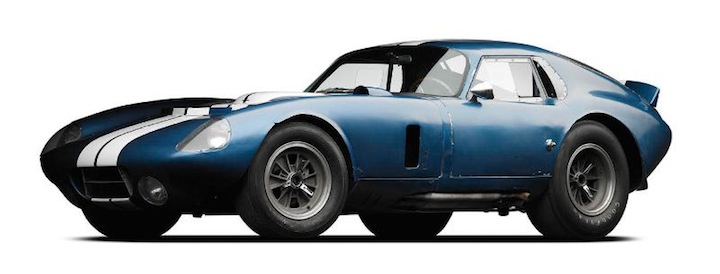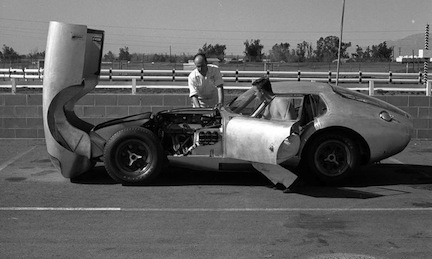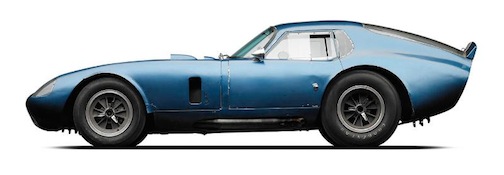1964 Shelby Cobra Daytona Coupe makes history again

(January 22, 2014) WASHINGTON — The Historic Vehicle Association (HVA) announced today that the 1964 Shelby Cobra Daytona Coupe will become the first automobile to be recorded under the Secretary of the Interior's Standards for Heritage Documentation. The documentation will be part of the HVA's National Historic Vehicle Register and Historic American Engineering Record (HAER) that is permanently archived in the Library of Congress.
The HVA and U.S. Department of the Interior collaborated on the effort and plan to document other historically significant automobiles.
The 1964 Shelby Cobra Daytona Coupe (CSX2287) was the first of six Daytona Coupes produced. The vehicle was completed 50 years ago, in January 1964 by Shelby American, Inc. in Los Angeles. The Daytona Coupe was designed by Peter Brock and enabled the Shelby American Cobra race team to compete successfully and win the International Manufacturer's GT Championship in 1965. This was the first time an American manufacturer won an international race series.
CSX2287, as it's known, is among the most historically significant automobiles in America. Its historic significance is based on its association with important persons and events; its construction and aerodynamic design; and informational value as one of the few race cars from the period that has not been completely restored.
The vehicle is part of the Simeone Foundation Automotive Museum in Philadelphia and is being displayed by the HVA at The Washington Auto Show from Jan. 22 – Feb. 2.
"Today is an important day for national automotive heritage," said Mark Gessler, president of the Historic Vehicle Association. "It has been nearly 120 years since the first automobiles were produced in the U.S. During that time, we have implemented national programs to recognize our historic buildings, airplanes, spacecraft and vessels but not our historic automobiles. Through our work, we hope to celebrate the contribution of the industry's pioneers, the vehicles they produced and the preservation efforts necessary to ensure future generations appreciate the unique roll of the automobile in shaping America."
 "We look forward to working with the Historic Vehicle Association to promote the cultural and historical significance of the automobile, protecting the future of our automotive past, and making a record of this rich history available to the public," said Richard O'Connor, chief, Heritage Documentation Programs, National Park Service, U.S. Department of the Interior.
"We look forward to working with the Historic Vehicle Association to promote the cultural and historical significance of the automobile, protecting the future of our automotive past, and making a record of this rich history available to the public," said Richard O'Connor, chief, Heritage Documentation Programs, National Park Service, U.S. Department of the Interior.
Over the coming year, the HVA will focus its efforts on documenting additional vehicles and continued work with the U.S. Department of the Interior to refine guidelines and processes to eventually support future public submission.
 The documentation process includes a fully referenced narrative and description of the vehicle, technical drawings of important elements of the vehicle and detailed photographs and film negatives for permanent archival in the Library of Congress. These standards for documentation involve the same level of care that has been used to record the Statue of Liberty and the Space Shuttle Discovery. Both domestic and foreign vehicles are considered provided they have significant American history.
The documentation process includes a fully referenced narrative and description of the vehicle, technical drawings of important elements of the vehicle and detailed photographs and film negatives for permanent archival in the Library of Congress. These standards for documentation involve the same level of care that has been used to record the Statue of Liberty and the Space Shuttle Discovery. Both domestic and foreign vehicles are considered provided they have significant American history.
"Having my Shelby Cobra Daytona Coupe design recognized as the very first car to be included in the permanent archives of the Library of Congress is a great honor and the thrill of a lifetime," said Peter Brock, Brock Racing Enterprises and the designer of the car.
"I'm very proud that the Shelby Cobra Daytona Coupe helped lead the way to American's first win in the FIA International Manufacturer's GT Championship in 1965. The Coupe's revolutionary design contributed to new standards for automotive aerodynamic efficiency. "
Dr. Frederick Simeone, executive director of the Simeone Foundation Automotive Museum, commented, "We are honored that our 1964 Shelby Cobra Daytona Coupe was selected as the first vehicle to achieve national heritage status. Part of our mission is to ensure the preservation of historically important automobiles, like this Cobra. With efforts like this from the HVA and Department of the Interior, future generations will be able to appreciate the tremendous contributions these cars made to automotive history."
The Simeone Foundation Automotive Museum is one of the most important collections of racing sports cars in the world. Assembled by renowned neurosurgeon Dr. Frederick Simeone over a span of 50 years, the Museum contains over 60 of the rarest and most significant racing sports cars ever built. The Simeone was chosen "Museum of the Year" by the International Historic Motoring Awards in London.
